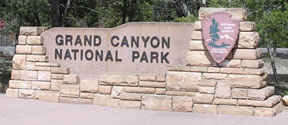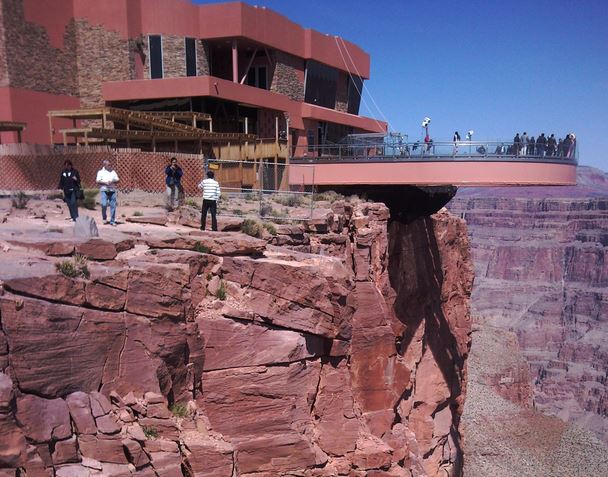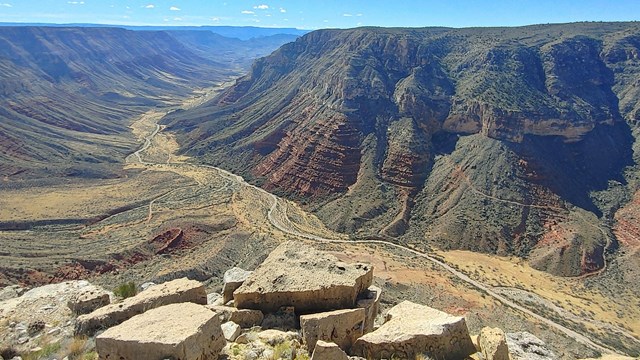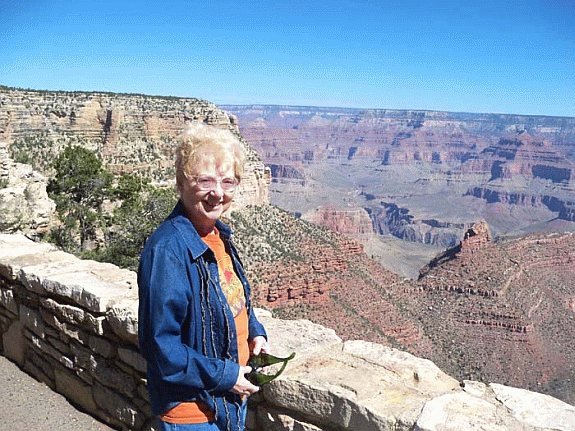 |
 |
View from Grandview Point |
Grandview Point is one of the most popular South Rim viewpoints in Grand Canyon National Park. It is located along Desert View Drive (SR 64), halfway between Grand Canyon Village (10.2 miles/16.4 K) and Desert View (13.8 miles/22.2 K). The viewpoint offers breathtaking panoramic views of the canyon and is known for stunning sunrises and sunsets. |
| |
Over 50% of the
Grand Canyon National Park
is in Mohave County! |
| |
Exploring the Grand Canyon
in Mohave County, Arizona |
 |
The Grand Canyon, one of the world's most stunning natural wonders, stretches over 277 miles along the Colorado River. A large portion of this majestic geological formation falls within Mohave County, located in northwestern Arizona.
While the Grand Canyon National Park primarily draws visitors to the South Rim, the Mohave County portion offers unique experiences in more secluded and diverse sections, including the famous West Rim and the vast wilderness areas of the Grand Canyon-Parashant National Monument.
The Grand Canyon, one of the Seven Wonders of the World exists among lush desert landscapes, crystal-clear waters and breathtaking mountain peaks.
Grand Canyon National Park is the United States' 15th oldest national park and is located in northwest Arizona. Within the park lies the Grand Canyon, a gorge of the Colorado River, considered to be one of the Wonders of the World.
 The park covers 1,217,403 acres of unincorporated area in Coconino and Mohave counties. The Grand Canyon divides Mohave county into two parts with an impassable gorge which no road crosses. The park covers 1,217,403 acres of unincorporated area in Coconino and Mohave counties. The Grand Canyon divides Mohave county into two parts with an impassable gorge which no road crosses.
A powerful and inspiring landscape, the Grand Canyon overwhelms our senses through its immense size; 277 river miles long, up to 18 miles wide, and a mile deep.
|
| |
Grand Canyon West
Home of the Skywalk |
 |
The Grand Canyon West region, located in Mohave County, is perhaps most famous for the Skywalk, a horseshoe-shaped glass bridge that extends 70 feet out over the canyon rim. Opened in 2007 and operated by the Hualapai Tribe, the Skywalk offers visitors a thrilling view of the canyon floor, 4,000 feet below. The tribe’s dedication to preserving the area’s natural beauty has led to the development of eco-friendly tourism.
In addition to the Skywalk, Grand Canyon West offers experiences such as:
- Helicopter tours over the canyon and down to the Colorado River.
- Whitewater rafting excursions along the Colorado.
- Hualapai Ranch, where visitors can engage in cowboy-themed activities and enjoy scenic horseback rides.
The region gives a unique cultural twist to the Grand Canyon experience with opportunities to learn about Hualapai traditions and legends.
|
| |
Grand Canyon-Parashant
National Monument |
 |
In the northwest corner of Mohave County, Arizona lies the Grand Canyon-Parashant National Monument, a lesser-known but extraordinary part of the Grand Canyon ecosystem. This remote wilderness covers over 1 million acres, managed jointly by the Bureau of Land Management and the National Park Service.
Parashant is an adventurer’s dream for those seeking solitude and rugged terrain. There are no paved roads or visitor services, making it an ideal location for off-road driving, backcountry hiking, and camping. Key features include:
|
| |
Mount Logan, offering spectacular views
of the canyon and beyond. |
| |
Lava flows and volcanic cones,
remnants of ancient volcanic activity. |
| |
St. George Basin, a stunning expanse of
desert landscape dotted with Joshua trees. |
| |
| Lake Mead and the Colorado River |
| |
| Water Adventures |
The Mohave County portion of the Grand Canyon also provides easy access to Lake Mead and the Colorado River, perfect for boating, fishing, and kayaking. One of the best ways to experience the canyon is by taking a rafting trip through the Colorado River’s rapids. The trips can range from half-day excursions to multi-day adventures that navigate the challenging currents and explore hidden waterfalls and caves. |
|
Wildlife and Ecosystems in
Mohave County’s Grand Canyon |
This part of the Grand Canyon offers an incredible diversity of ecosystems, ranging from arid desert to coniferous forests. Wildlife enthusiasts will have the chance to spot a variety of animals, including: |
|
Desert bighorn sheep, often seen navigating the cliffs with ease. |
| |
California condors, the largest flying bird in North America, soaring above the canyon. |
| |
Elk, mule deer, and a host of smaller mammals such as foxes and ringtails. |
| |
Reptiles, including the desert tortoise and rattlesnakes, thrive in the lower elevations. |
| |
Plant life is equally diverse, with yucca, creosote bushes, pinyon pines, and juniper trees covering different parts of the landscape. This combination of flora and fauna highlights the unique biodiversity of the Grand Canyon’s Mohave County region. |
| |
Visiting Tips for
Mohave County’s Grand Canyon |
|
Plan for remote travel: Some areas, especially the Parashant National Monument, require high-clearance, 4x4 vehicles due to unpaved roads.
-
Pack sufficient supplies: In the more remote sections, there are no visitor centers or water sources.
-
Respect tribal land: Portions of Grand Canyon West are located on Hualapai land, and visitors should be mindful of cultural sensitivities.
-
Dress for varying conditions: Temperatures can fluctuate drastically, with scorching days in summer and freezing nights in winter.
You Just Got To See It!
The Grand Canyon’s Mohave County portion is a hidden gem waiting to be explored. Whether you seek the adrenaline of the Skywalk at Grand Canyon West, the solitude of the Parashant wilderness, or water-based adventures on the Colorado River, this part of the Grand Canyon offers something for everyone. Embrace the beauty, history, and cultural significance of Mohave County’s Grand Canyon, and you’ll experience one of the most remarkable regions in the American Southwest. |
| |
| |
 |
Most visitors to the park come to the South Rim, arriving on Arizona State Route 64 which connects with I-40 at Williams, Arizona about 60 miles south of the park. Arizona State Route 64 enters the park through the South Entrance, two miles north of Tusayan, Arizona,
The beauty of the Grand Canyon, one of the 7 Natural Wonders of the World, is like nothing else you will ever experience. Each season of the year provides a unique vista. |
Click Here for Pictures of
The Grand Canyon |
From the flowers of spring and the scent of the pine forest after a summer rain to the colors of autumn and the spectacle of snow during the winter months, your vacation to the Grand Canyon is a treat for the senses.
SUMMER temperatures on the South Rim are relatively pleasant. North Rim temperatures are a few degrees cooler due to the higher elevation. Inner canyon temperatures are extreme. Daytime highs at the river often exceed 105 degrees F. Thunderstorms frequently occur during July, August, and early September.
WINTER conditions on the South Rim can be extreme. The road into the North Rim is closed from the first heavy snow in November or early December to mid-May.
SPRING and FALL. Come prepared for a variety of conditions. Pleasant weather can change to rain or cold.
People from around the world marvel at the color, sound, art and performances of those whose ancestors made the Grand Canyon their home.Welcome to the experience, adventure and breathtaking beauty. Welcome to the Grand Canyon! |
| |
|
| |
 |
| |
|